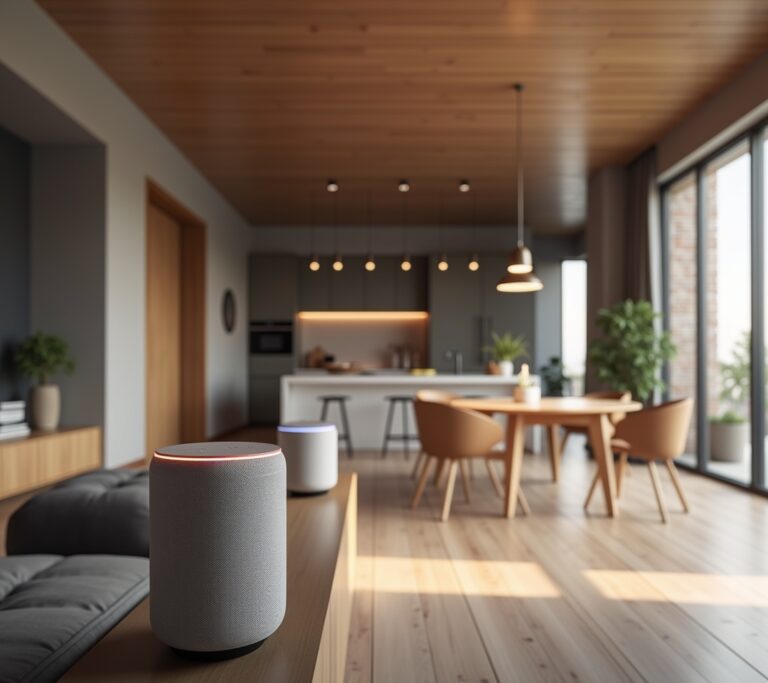Advertisements
You know that feeling when you walk into your house and everything just… happens? Last week, I nearly jumped out of my skin when my entire living room lit up, music started playing, and the thermostat adjusted itself – all because I’d forgotten about the “Welcome Home” scene I’d programmed the night before! That’s the magic (and sometimes chaos) of advanced smart home scenes.
If you’re still manually turning on lights and adjusting your thermostat like it’s 2010, you’re missing out on some serious home automation goodness. Smart home scenes can transform your daily routines from tedious checklists into seamless experiences. And trust me, once you get the hang of creating complex automation scenarios, you’ll wonder how you ever lived without them.
What Makes a Scene “Advanced” Anyway?

So here’s the thing – basic scenes are pretty straightforward. You tap a button, your lights dim, maybe your TV turns on. Been there, done that.
Advanced scenes, though? They’re like the Swiss Army knives of home automation. We’re talking multiple triggers, conditional logic, and device orchestration that would make a symphony conductor jealous. I once spent three hours programming a “Movie Night” scene that checks if it’s after sunset, confirms someone’s actually home, gradually dims the lights over 30 seconds, closes the blinds, turns on the TV and sound system, and even starts the popcorn maker in the kitchen.
The real game-changer is when you start using variables and conditions. My morning routine scene actually checks the weather and adjusts my bedroom lights accordingly – brighter on cloudy days, softer when it’s already sunny. It took me forever to figure out how to integrate weather data from Home Assistant, but man, was it worth it!
Building Your First Multi-Trigger Scene
Okay, let’s get our hands dirty. The secret sauce to advanced scenes is understanding triggers and conditions.
Start with something practical – I call mine “Bedtime for Real This Time.” Here’s what makes it tick:
- Triggers when motion stops in the bedroom after 10 PM
- BUT only if the TV is off (learned this one the hard way)
- AND only if it hasn’t already run in the last hour
- Gradually dims lights over 15 minutes
- Locks all doors
- Sets the thermostat to sleep mode
- Activates the white noise machine
The trickiest part was getting the motion sensor timeout just right. Too short, and the scene triggers every time you roll over. Too long, and you’re lying there in bright lights wondering why nothing’s happening!
Geofencing and Presence Detection Magic
This is where things get really cool. Geofencing basically means your house knows where you are, which sounds creepy but is actually awesome.
My “Almost Home” scene starts working its magic when I’m about 5 minutes away. The house springs to life – lights turn on, the heating kicks in during winter, and my robot vacuum scoots back to its dock (because nobody wants to trip over that thing in the dark). The key is getting your geofencing radius just right; I learned that 500 meters works perfectly for my commute.
But here’s a pro tip that took me months to figure out: combine multiple presence detection methods. I use both phone location and a Bluetooth beacon in my car. Why? Because phones die, GPS glitches, and sometimes my wife borrows my car. Having redundancy means my scenes actually work when I need them.
Voice Commands That Actually Make Sense
Nothing makes you feel more like you’re living in the future than saying “Hey Google, movie time” and watching your whole room transform. But getting voice commands right for complex scenes is an art form.
I’ve made every mistake in the book. My first attempt at a “Goodnight” command turned off ALL the lights in the house – including the ones my wife was using to read downstairs. That was a fun conversation!
Now I use specific, contextual commands:
- “Bedtime upstairs” only affects the second floor
- “Kitchen cleanup” brightens task lighting and starts a 30-minute timer
- “Party mode” … well, that one’s self-explanatory and involves color-changing bulbs
Time-Based Scenes That Adapt to Your Life
Static schedules are so yesterday. My morning routine used to blast lights at 6 AM sharp every day – including weekends. Not cool.
Advanced scenes should know the difference between Tuesday and Saturday. Mine now check my calendar through Google Calendar integration and adjust accordingly. Work day? Gentle wake-up starting at 6. Weekend? The house stays quiet until it detects movement.
The real breakthrough came when I realized I could use my phone’s alarm as a trigger. Set your alarm for 7 AM? The house starts its wake-up routine 10 minutes before. It’s like having a really smart butler who actually pays attention to your schedule.
Making It All Work Together (Without Losing Your Mind)

Here’s something nobody tells you about advanced smart home scenes – they can conflict with each other in spectacular ways. I once had my “Good Morning” and “Leaving Home” scenes fighting over the thermostat for twenty minutes. The temperature kept bouncing between 72 and 65 degrees like a ping pong ball.
The solution? Scene priorities and mutual exclusions. Think of it like traffic rules for your automations. High-priority scenes (like security-related ones) always win. And some scenes should cancel others – when “Movie Night” starts, it automatically disables “Motion Lighting” in the living room.
Testing is crucial, and I mean really testing. Have someone else try your scenes while you watch what happens. You’d be amazed at the edge cases you’ll discover. My brother-in-law managed to trigger three different scenes simultaneously just by walking through my house normally!
Your Smart Home, Your Rules
At the end of the day, the best smart home scenes are the ones that make YOUR life easier. Maybe you don’t need a robot vacuum to hide when you come home, but you’d love lights that follow you from room to room at night.
Start small, test everything, and don’t be afraid to tweak things that annoy you. And remember – with great automation comes great responsibility. Always include manual overrides, because sometimes you just want to flip a switch like a normal person!
Ready to dive deeper into the world of home automation? Check out more guides and tips at Tech News 360 – we’re always exploring the latest ways to make your home smarter (and occasionally sharing our automation fails for your entertainment).




[…] to dive deeper into smart home tech? Check out more reviews and guides at Tech News 360 – we’re always testing the latest gadgets to separate the game-changers […]